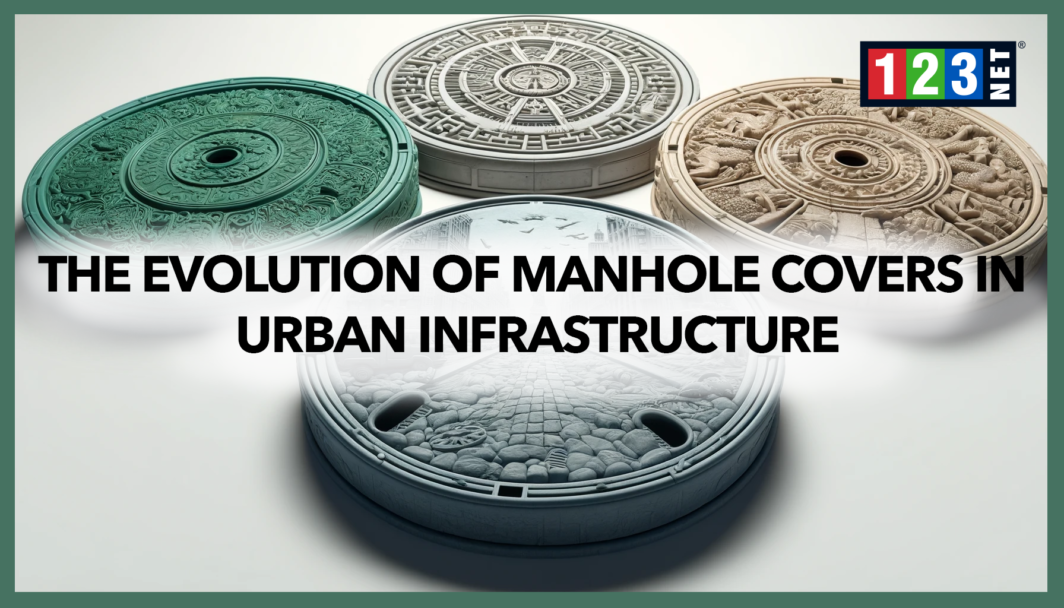
Introduction
Manhole covers are crucial components of urban infrastructure, providing secure and accessible entry points to underground utilities like sewers and storm drains. These covers protect pedestrians and vehicles from open holes and prevent unauthorized access, playing a pivotal role in urban safety and maintenance. Manhole covers come in various types, each tailored to specific applications and load requirements. This introduction explores the significance of these covers and provides a brief overview of the different types, including cast iron, ductile iron, and composite materials, highlighting their diverse applications in maintaining urban infrastructure.
History and Development of Manhole Covers
The evolution of manhole covers spans several millennia, beginning with ancient civilizations that used stone or wooden covers to secure entry to underground utilities. These early covers were rudimentary, primarily focusing on functionality rather than durability or safety. As urbanization progressed, the need for more durable materials became apparent, leading to the use of cast iron in the 19th century, which marked a significant development in the design of manhole covers.
The industrial era brought about major changes in the manufacturing processes and materials used for manhole covers. Cast iron, known for its strength and ability to withstand heavy loads, became the standard material, especially in burgeoning urban centers that required robust solutions for their expanding infrastructure. The 20th century introduced ductile iron, an innovation that offered enhanced durability and resistance to breakage compared to traditional cast iron. Ductile iron’s superior weight-to-strength ratio made it ideal for areas with heavy traffic and variable environmental conditions.
Further advancements came with the introduction of composite materials, which provided solutions to issues like theft (due to the scrap value of iron) and corrosion that plagued iron covers. These composites, made from materials such as fiberglass, resin, and recycled plastics, are not only lighter and easier to handle but also resistant to weather and chemical wear, which extends their lifespan and reduces maintenance needs.
These material innovations were accompanied by design improvements, such as non-slip surfaces, customized fittings for different applications, and increased load-bearing capabilities. The evolution of manhole covers illustrates a trajectory of continuous improvement and adaptation to meet the changing needs of urban environments, highlighting the interplay between technological advancement and urban planning.
Types of Manhole Covers
Manhole covers, essential components of urban infrastructure, come in various materials each suited to different environmental and operational demands.
Cast Iron Covers:
Cast iron manhole covers are renowned for their robustness and durability, making them ideal for environments that demand high load-bearing capacity. These covers are a common sight in city centers and industrial zones where heavy vehicular traffic is a regular occurrence. The weight and strength of cast iron help prevent displacement by traffic or unauthorized removal, providing a secure barrier to underground utilities.
Ductile Iron Covers:
An advancement in metallurgy gave rise to ductile iron, a variant of cast iron that includes small amounts of magnesium which transform its graphite content into a more flexible, spherical shape, enhancing its impact resistance and strength. Ductile iron covers are particularly valued in areas with severe service conditions, such as frequent heavy traffic and significant temperature fluctuations. They combine the traditional benefits of cast iron with greater resilience to bending and breaking under stress.
Composite Material Covers:
Modern urban settings have spurred the adoption of composite material covers. Which are fabricated from a mixture of fiberglass, resin, and recycled plastic. These materials offer excellent resistance to corrosion and reduce the risk of theft due to their lack of scrap value. Composite covers are significantly lighter than metal alternatives, making installation and maintenance easier while still providing adequate strength. Their non-conductive properties enhance safety in areas prone to electrical and thermal exposure.
Other Types:
Innovations in manhole cover design also cater to specialized requirements. High-security covers incorporate tamper-proof features and alarm systems to protect sensitive infrastructure. Others include built-in ventilation or are made from materials specifically chosen for chemical resistance or reduced noise from traffic. These specialized covers demonstrate the adaptability of manhole cover designs to meet a variety of urban challenges. It is ensuring safety and functionality across diverse applications.
Each type of manhole cover plays a vital role in maintaining the integrity and efficiency of urban infrastructure. It is reflecting a sophisticated balance of material science and engineering design tailored to specific environmental and operational conditions.
Manufacturing Processes
The manufacturing of manhole covers involves sophisticated processes that have evolved significantly with advancements in technology and materials science. This section explores the primary manufacturing techniques for various types of manhole covers. It is emphasizing the roles of casting, machining, and assembly in their production.
Casting Process:
Casting is the most common method used in the manufacture of metal manhole covers, particularly for iron. It involves pouring molten metal into molds that are shaped as the final product. This process allows for the mass production of durable and heavy-duty covers. Advances in metallurgical technology have improved the quality and consistency of cast metal, enhancing the structural integrity of the covers.
Machining Process:
Following casting, machining is often employed to achieve precise dimensions and smooth finishes. This process is crucial for ensuring that covers fit perfectly into their frames. This is minimizing the risk of displacement or noise as vehicles pass over them. Modern machining techniques utilize computer-controlled equipment to maintain high accuracy and efficiency.
Assembly and Finishing:
Assembly involves adding components such as lifting hooks and anti-slip surfaces. The finishing process may include painting or coating to prevent corrosion, especially in harsh environments. These steps are critical for extending the lifespan and maintaining the aesthetic appeal of the covers.
Global Manufacturing Centers:
Major manufacturing centers in countries like China, India, and Germany play significant roles in the global market. Their capacity to innovate and scale production influences market dynamics and availability. These centers continuously adopt new technologies to enhance production efficiency and adapt to changing market demands and regulatory standards.
Through these sophisticated manufacturing processes, the industry ensures that manhole covers not only meet safety standards but also address the specific needs of urban infrastructure around the world. This commitment to quality and innovation helps maintain the reliability and safety of public utilities.
Applications of Manhole Covers
Municipal and Roads
Manhole covers play a critical role in the fabric of urban planning and infrastructure maintenance. As essential elements in municipal and roadway systems, they ensure safe and continuous access to underground utilities. This is facilitating routine inspections and urgent repairs. These covers are designed to withstand the rigors of heavy traffic, thus bolstering road safety and infrastructure durability. Their ability to maintain integrity under the weight of urban traffic and resist environmental degradation makes them indispensable in city landscapes.
Communication and Power
In the realm of communication and power, manhole covers serve as protective guardians for crucial infrastructure. These covers are strategically placed over access points to shield sensitive communication lines and electrical power systems from environmental harm and unauthorized interference. The robust construction of these covers prevents potential damage from water ingress, debris, or vandalism. Thereby ensuring consistent and reliable service delivery across communication and power networks.
Others
The versatility of manhole covers extends beyond these common applications. In emergency situations, these covers provide vital access routes for rescue and recovery operations, enabling quick response times. Additionally, in industrial settings, specialized manhole covers are used to secure access to chemical conduits or heat distribution systems. These specialized covers may feature enhanced chemical resistance, thermal insulation, or noise-reduction properties, tailored to meet specific industrial requirements.
Manhole covers also contribute significantly to environmental protection and public safety. They prevent pollutants from entering subterranean water channels and reduce the risk of accidents by keeping pedestrian and vehicular traffic away from potentially hazardous openings. This multifunctional utility demonstrates the essential role of manhole covers in supporting the complex and varied needs of modern urban environments. This is making them a fundamental component of public utilities management. Through thoughtful design and strategic placement, manhole covers continue to safeguard both the public and the environment. This is while supporting the seamless operation of urban and industrial services.
Market Analysis
The market for manhole covers is currently witnessing significant changes. This is shaping the demands of expanding urban landscapes and infrastructure modernization. A notable trend is the increasing demand for covers that are both more durable and require minimal maintenance. This shift is largely driven by the need to accommodate higher traffic volumes and reduce the frequency of replacements and repairs, which can disrupt urban life.
The COVID-19 pandemic has also played a role in transforming the market. While initially causing disruptions in global supply chains, it has spurred innovations within the industry. Manufacturers have responded by developing new materials and designs that not only meet heightened safety standards but also adhere to stricter environmental regulations. These innovations are aiming at producing manhole covers that are lighter, stronger, and more resistant to corrosion and wear.
Looking to the future, the market for manhole covers is poise for growth. This optimism is underpin by continuous advancements in materials science, which promise to deliver even more resilient and eco-friendly products. Additionally, there is a growing emphasis on sustainability in urban planning, which favors the development of infrastructure components that contribute to environmental protection and conservation.
Overall, as cities continue to grow and evolve, the demand for high-quality, innovative manhole covers is expecting to rise. This demand will drive further advancements in the field. It will be ensuring that manhole covers can meet the evolving needs of modern urban environments. As while as supporting broader goals of sustainability and resilience.
Installation and Maintenance
Once installed, maintaining manhole covers involves regular inspections to assess their condition. These inspections should check for signs of wear such as cracks, rust, or displacement, which could compromise the cover’s integrity and safety. Workers are inspecting the surrounding area to ensure that no subsidence is undermining the installation.
Cleaning is also vital; debris and dirt can accumulate around the edges, potentially causing the cover to stick or become difficult to open. This can be particularly problematic for utility workers needing access for inspections or emergency repairs. Lubricating the hinges and locks can help maintain their operation and prevent corrosion.
Timely replacement of manhole covers is crucial. Factors like traffic volume, environmental conditions, and the material of the cover will influence its lifespan. Replacing old or damaged covers before they fail is essential to prevent accidents and maintain the integrity of the urban infrastructure.
Following these installation and maintenance steps ensures that manhole covers remain functional and safe, supporting the continuous operation of urban services and protecting the public.
Safety and Regulatory Standards
Safety concerns regarding manhole covers primarily involve preventing traffic accidents and utility failures. Properly designed and maintained manhole covers are crucial for ensuring public safety and the continuous operation of urban utilities. This section highlights the regulatory standards and compliance requirements that govern the use of manhole covers across different regions.
Regulatory bodies enforce standards that specify the materials, design, and testing methods for manhole covers. This is to ensure they can withstand the demands of urban environments. These standards are design to mitigate risks such as cover displacement or failure. This can lead to traffic accidents or pedestrian injuries. Additionally, these regulations mandate how covers must seal to prevent toxic gas escape or water ingress that can cause utility failures.
Compliance with these standards is mandatory and monitored through regular inspections and audits. Manhole covers that meet these guidelines are certified for use, ensuring they provide the necessary level of safety and reliability. Manufacturers and municipalities must adhere to both local and international safety standards, which may vary but generally aim to protect public health and safety by requiring durable, secure, and correctly installed manhole covers.
Adhering to these safety standards helps prevent accidents, maintain service reliability, and ensure that manhole covers contribute positively to the safety and functionality of urban infrastructure.

FAQs
- Why are manhole covers round? A: Circular covers cannot fall through their own opening, making them safer and easier to handle.
- How often should manhole covers be replaced? A: Replacement depends on usage and environmental conditions, typically every 30 years or as needed.
- Can manhole covers be recycled? A: Yes, especially metal covers can be melted down and reformed into new products, aligning with environmental sustainability efforts.




